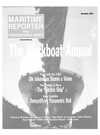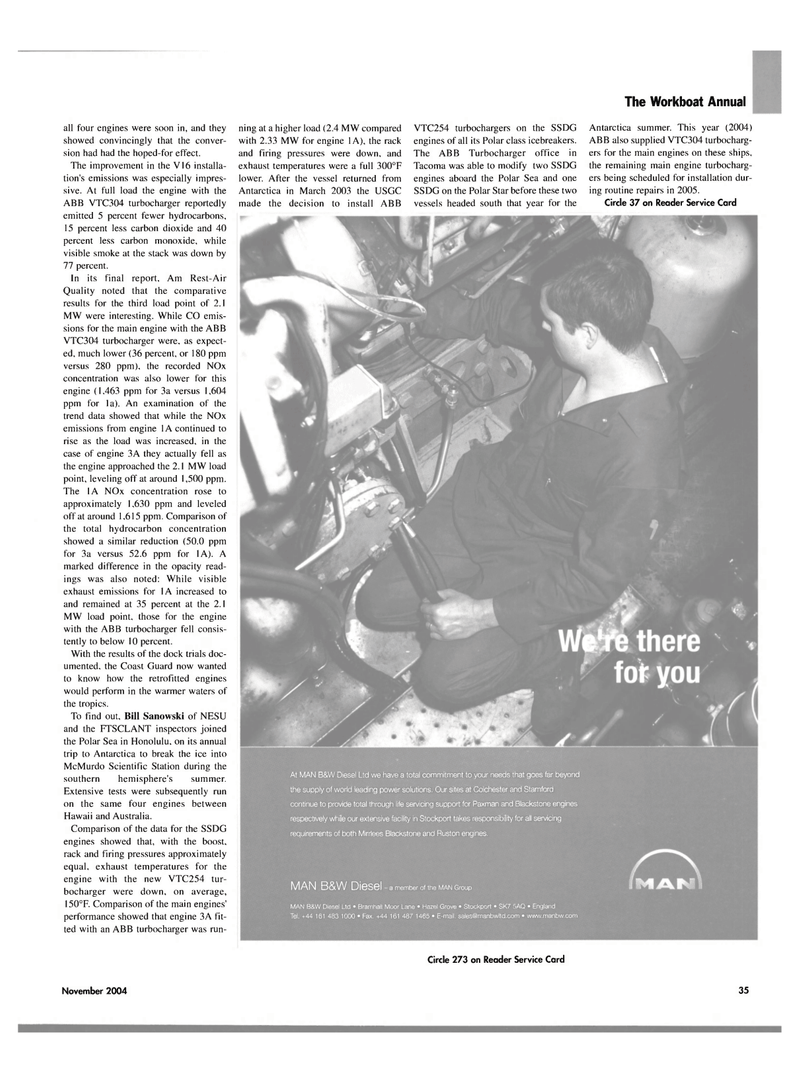
Page 35: of Maritime Reporter Magazine (November 2004)
The Workboat Annual
Read this page in Pdf, Flash or Html5 edition of November 2004 Maritime Reporter Magazine
The Workboat Annual all four engines were soon in, and they showed convincingly that the conver- sion had had the hoped-for effect.
The improvement in the VI6 installa- tion's emissions was especially impres- sive. At full load the engine with the
ABB VTC304 turbocharger reportedly emitted 5 percent fewer hydrocarbons, 15 percent less carbon dioxide and 40 percent less carbon monoxide, while visible smoke at the stack was down by 77 percent.
In its final report. Am Rest-Air
Quality noted that the comparative results for the third load point of 2.1
MW were interesting. While CO emis- sions for the main engine with the ABB
VTC304 turbocharger were, as expect- ed, much lower (36 percent, or 180 ppm versus 280 ppm), the recorded NOx concentration was also lower for this engine (1.463 ppm for 3a versus 1,604 ppm for la). An examination of the trend data showed that while the NOx emissions from engine 1A continued to rise as the load was increased, in the case of engine 3A they actually fell as the engine approached the 2.1 MW load point, leveling off at around 1,500 ppm.
The 1A NOx concentration rose to approximately 1,630 ppm and leveled off at around 1,615 ppm. Comparison of the total hydrocarbon concentration showed a similar reduction (50.0 ppm for 3a versus 52.6 ppm for 1A). A marked difference in the opacity read- ings was also noted: While visible exhaust emissions for 1A increased to and remained at 35 percent at the 2.1
MW load point, those for the engine with the ABB turbocharger fell consis- tently to below 10 percent.
With the results of the dock trials doc- umented, the Coast Guard now wanted to know how the retrofitted engines would perform in the warmer waters of the tropics.
To find out. Bill Sanowski of NESU and the FTSCLANT inspectors joined the Polar Sea in Honolulu, on its annual trip to Antarctica to break the ice into
McMurdo Scientific Station during the southern hemisphere's summer.
Extensive tests were subsequently run on the same four engines between
Hawaii and Australia.
Comparison of the data for the SSDG engines showed that, with the boost, rack and firing pressures approximately equal, exhaust temperatures for the engine with the new VTC254 tur- bocharger were down, on average, 150°F. Comparison of the main engines' performance showed that engine 3A fit- ted with an ABB turbocharger was run- ning at a higher load (2.4 MW compared with 2.33 MW for engine 1 A), the rack and firing pressures were down, and exhaust temperatures were a full 300°F lower. After the vessel returned from
Antarctica in March 2003 the USGC made the decision to install ABB
VTC254 turbochargers on the SSDG engines of all its Polar class icebreakers.
The ABB Turbocharger office in
Tacoma was able to modify two SSDG engines aboard the Polar Sea and one
SSDG on the Polar Star before these two vessels headed south that year for the
Antarctica summer. This year (2004)
ABB also supplied VTC304 turbocharg- ers for the main engines on these ships, the remaining main engine turbocharg- ers being scheduled for installation dur- ing routine repairs in 2005.
Circle 37 on Reader Service Card
Circle 273 on Reader Service Card
At MAN B&W Diesel Ltd we have a total commitment to your needs that goes far beyond the supply of world leading power solutions. Our sites at Colchester and Stamford continue to provide total through life servicing support for Paxman and Blackstone engines respectively while our extensive facility in Stockport takes responsibility for all servicing requirements of both Mirrlees Blackstone and Ruston engines.
MAN B&W Diesel a member of the MAN Group
MAN B&W Diesel Ltd • Bramhall Moor Lane • Hazel Grove • Stockport • SK7 5AQ • England
Tel. +44 161 483 1000 • Fax. +44 161 487 1465 • E-mail, [email protected] • www.manbw.com
November 2004 35

 34
34

 36
36
